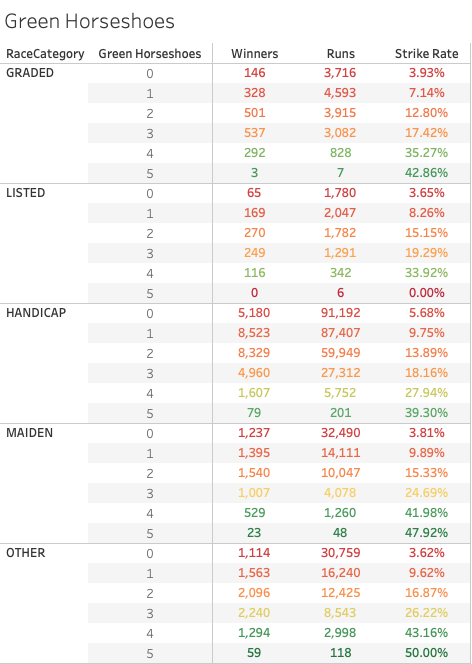Using Horseshoes To Shortlist Race Contenders

- theturtle
- 11 Oct 2024
BetTurtle horseshoe ratings are powerful and are a great way to narrow down the contenders in a race quickly.
This article provides insights into how to use the BetTurtle horseshoe ratings to quickly and easily shortlist the contenders in a race.
It uses data from the 2021-2024 seasons.
Horseshoes
BetTurtle uses 5 horseshoes to create a visual form representation for each horse.

Fitness (F) - Past performances, trainer form and horses racing patterns to gauge how fit or primed to run well the horse may be.
Ability (A) - Past performances, sales, sire, trainer and owner data to assess the horses potential ability.
Conditions (C) - Past peformances, sire performances and jockey bookings to gauge suitability of today's conditions.
Vibes (V) - Uses various tipsters, social media and press data to assess the vibes surrounding a horses well being in the race.
Market (M) - Continuously analyses the betting markets until off time.
The horseshoe colours depict the following.
Green Horseshoe - A positive sign.
Amber Horseshoe - There is limited information available to assess the horse, such as first time runner, trying a new distance, going or race class, etc. This could be a positive or negative sign.
Red Horseshoe - A warning sign, so tread carefully.
Fitness Horseshoe
The following are the win, runner and strike rate stats for the fitness horseshoe across all race categories.

As the stats show across all race categories, horses with a green fitness horseshoe have a distinct advantage and those with red horseshoes a distinct disadvantage.
Ability Horseshoe
The following are the win, runner and strike rate stats for the ability horseshoe across all race categories.

As the stats show across all race categories, horses with a green or amber ability horseshoe have a distinct advantage and those with red horseshoes can often be ruled out.
Conditions Horseshoe
The following are the win, runner and strike rate stats for the conditions horseshoe across all race categories.

As the stats show across all race categories, horses with a green conditions horseshoe have a distinct advantage and those with amber and red horseshoes a disadvantage.
Vibes Horseshoe
The following are the win, runner and strike rate stats for the vibes horseshoe across all race categories.

As the stats show across all race categories, horses with a green vibes horseshoe have a distinct advantage and those with red horseshoes can often be ruled out.
Market Horseshoe
The following are the win, runner and strike rate stats for the market horseshoe across all race categories.

As the stats show across all race categories, horses with a green or amber market horseshoe have a distinct advantage and those with red horseshoes can often be ruled out.
Combining Horseshoes
While individual horseshoes are worth considering, combining the horseshoes provides further insights. The tables below show how the number of different coloured horseshoes can impact the results too.
Green Horseshoes
The table below shows the stats for the number of green horseshoes a horse has across fitness, ability, conditions, vibes and market.

With the exception of Listed, which is explained by the fact there has only been 6 all green runners, the higher the number of green horseshoes the better chance a horse has of winning a race.
Horses with zero green horseshoes, can often be excluded from consideration.
Amber Horseshoes
The table below shows the stats for the number of amber horseshoes a horse has across fitness, ability, conditions, vibes and market.

Horses with two or more amber horseshoes have a decent strike rate across all race types.
Horses with zero amber horseshoes, can often be excluded from consideration.
Red Horseshoes
The table below shows the stats for the number of red horseshoes a horse has across fitness, ability, conditions, vibes and market.

Horses with zero red horseshoes have a distinct advantage.
Horses with two or more red horseshoes have a poor strike rate across all race types.
Horses with 3 or more red horseshoes, can often be excluded from consideration.
Next Steps
As you can see from the analysis above, the BetTurtle horseshoes are very powerful and can provide a quick way to assess the likely winning candidates in a race.
Our recommendations are as follows.
- Only consider backing a horse with red horseshoes at decent odds. The more red horseshoes, the bigger the price should be.
- If you don't have the time or inclination to study the form for every runner in a race. Simply set a BetTurtle filter to eliminate horses with 2 or more red horseshoes. To do this click the Horses Filter button on any racecard and set the following filter. Only horses with 0 or 1 red horseshoes will then be displayed on the race card.

- Bet as close to off time as possible, as horseshoes update throughout the day due to market moves, race going changes, non runners, etc.





